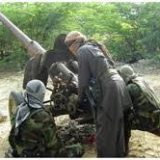Shabab decapitation
ON SEPTEMBER 1st American aircraft, both manned and unmanned, unleashed a volley of missiles and bombs on a convoy of vehicles close to the coastal city of Barawe in southern Somalia (see map). The strike killed Ahmed Abdi Godane, emir of the Shabab, an Islamist group battling a coalition of African Union and government forces, and a dozen senior commanders and foreign fighters.
The strike is the latest setback for Shabab, which controlled swathes of territory in southern and central Somalia at its zenith in 2010, but which has since been expelled from the capital, Mogadishu, and a number of key towns. Faced with these changing circumstances, Mr Godane had promoted the Amniyat, a secret elite force within the Shabab responsible for roadside and suicide bombs within Somalia and terrorist attacks in east Africa. Its highest-profile action was on the Westgate shopping mall in Kenya’s capital, Nairobi, which killed at least 67 people a year ago.
After swearing allegiance to al-Qaeda in 2012, Mr Godane purged a number of rivals within his organisation. In the process he became synonymous with the Shabab. His death is therefore significant and could herald a period of turbulence within the group, some of whose remaining leaders differ ideologically with one another.
On September 6th the Shabab reiterated its allegiance to al-Qaeda and named as emir Ahmad Umar Abu Ubaidah, a cousin and senior adviser to Mr Godane. Intelligence officials speak of Abu Ubaidah as instrumental to the creation of Amniyat and to Mr Godane’s purges of the Shabab.
It is unclear whether Abu Ubaidah will manage to assert the same centralised control as Mr Godane: different factions are arguing over whether to focus on fighting the Somali government at home or to pursue closer links with al-Qaeda or Islamic State (IS) and a more international agenda. Shabab operatives have already fostered connections with al-Qaeda in Yemen, with IS and with Shabab’s own al-Hijra franchise in Kenya. Factions could compete for the leadership by seeking to mount larger or more spectacular attacks than their rivals. Just two days after the new emir’s appointment the Shabab staged twin suicide attacks against a Somali government convoy and an African Union military convoy on the road from Mogadishu to Afgoye. Twelve people were killed.
Meanwhile, the Shabab still has access to millions of dollars, mainly through the production of charcoal exported by sea to the Arabian Gulf. It also receives regular deliveries of weapons and explosives across the Gulf of Aden from Yemen. International naval forces are itching for greater powers of interdiction to stop boats carrying charcoal and weapons, but plans have stalled as the UN Security Council squabbles. Corruption also blights the Somali security forces; they have received large quantities of weapons, some of which have found their way to the Shabab.
The last Shabab commander to die in an air strike was Sahal Iskudhuq, a member of theAmniyat, who was killed on January 26th. But thus far the Islamists have kept fighting back.




















